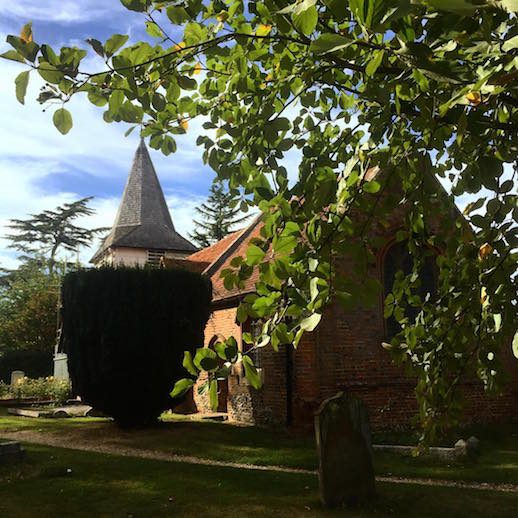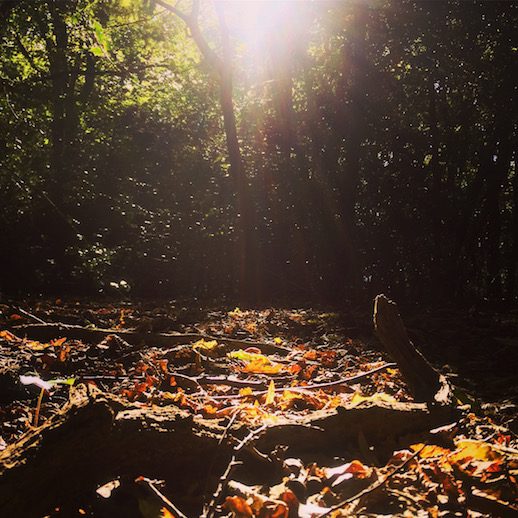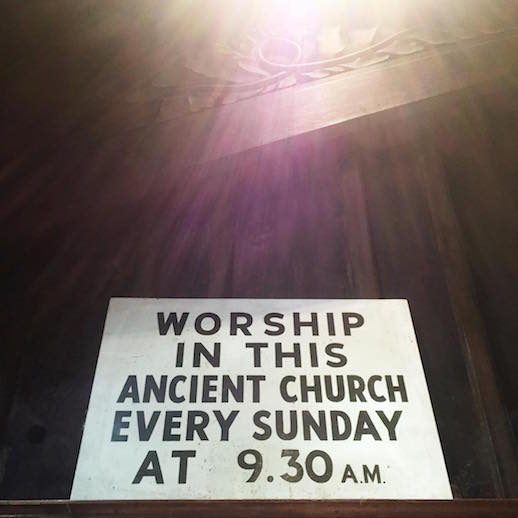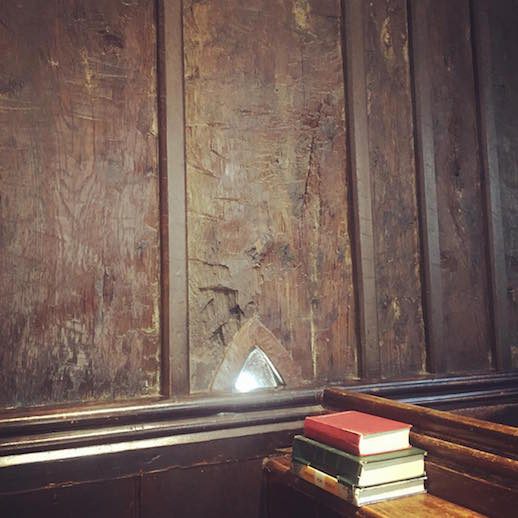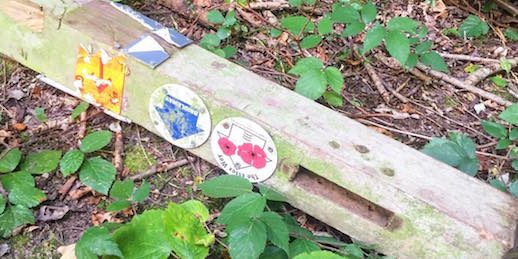Words and pictures: Luke Turner
The oldest remaining vertical timbers of Epping Forest have been dead for nearly a thousand years. I discovered Greensted Church, Britain’s most ancient wooden building, via a Pathé newsreel and a Google search, a coughing bus, a short walk via Chipping Ongar Sainsbury’s and a decapitated pigeon being eaten by frantic wasps. I’ve been visiting places of worship since the day the hospital discharged me after my birth – an event that was, simultaneously, almost my demise. I don’t go so much these days. You know what they say though: you can take the boy out of the church…
The Epping Forest landscape is scattered with sacred places that have powerfully shaped my relationship with it. It began, after all, with my great great grandfather’s baptism in the old High Beech church, now marked by the ditches that are the ghosts of its walls. During the Blitz, a bomb exploded on Loughton Methodist church and a lump of masonry crashed through the roof of my granny’s house on Habgood Road and onto her bed. Thankfully she had been evacuated, along with my uncle, to the Cotswolds. Two decades later, after dad’s conversion to the Christian faith, the sight of the head of the TUC and chairman of ICI kneeling together at communion convinced him that Methodism offered the egalitarianism he believed was at the heart of the teachings of Jesus. My granny’s funeral was in the modern incarnation of that same church, built in 1987. Hers was the first death I had known and I remember to this day, nearly 20 years later, the sense of peaceful sorrow in the back of the hearse as it drove down the length of Epping Forest through Buckhurst Hill and Woodford to the leafy City of London crematorium in the south at Wansted Flats. I often think it was that journey that sealed my fascination with the place, that all these words of mine are her memorial.
Unlike many who’ve grown up from birth surrounded by religion, I’ve never been able, let alone wanted, to scream at God or deny the possibility of energies beyond our understanding. I certainly have my issues with the church as an institution and its frequent inflexibility on morality, sexuality and the worth of other faiths, but rarely its people, and certainly not its buildings. The ancient timbers of Greensted know no hypocrisy or bigotry, but are prayers carved from nature, as sacred as hymns.
Greensted means a ‘clearing in the forest’, for in Saxon times the great woodland stretched beyond the boundaries set by the 1878 Epping Forest Act. This building made from its timbers is a monument not just to the early church but the vastness of the old English woodlands . Analysis of the vertical planks, or staves, of the church wall, curved on the outside and adzed flat in the interior, suggests that the trees were felled nearly 1000 years ago and came from an area of continuous woodland, rather than pasture or hedgerow. An archaeological dig in the more recent brick chancel found evidence of a far older wooden structure on the site. Perhaps this was the chapel in which the martyred body of Saxon King Edmund (the first patron saint of England before he was usurped by the more violent Norman George), was said to have rested. It might equally have been a pagan structure, for early Christianity knew all about how to co-opt the old beliefs before destroying them.
These myths and histories, coupled with the knowledge that for hundreds of years this enclosed air has circulated around and through forgotten generations, have given Greensted sense of peace. Yet for all its age, it feels used and alive, no mere relic. Light from a lamp on the ceiling cascades down on a sign encouraging us to “worship in this ancient church every Sunday at 9:30am”. I’d met up with Amanda, a local woman who lent me folders of printouts of the tree ring analysis and research that dated the building. She told me that they have a congregation of 20 a week, which seems like good going for such an early hour at a church where very few live within walking distance.
At the back of the church, prayer leaflets, tea-towels and greetings cards (some spiritual some secular) were available for sale, put your money in the honesty box. You could also buy jars of Greensted Church chutney, piccalilli, jam and so on, though I suspected they were bought as a job lot and the stickers featuring a picture of the building added on later. I wondered if some more stringent parishioners might imagine Jesus angrily lobbing jars of faux-local honey out of the church porch as if they were the money lenders in the temple.
On the pulpit sat a Liliput Lane model of Greensted Church, one of those twee ornaments that circulate around the elderly of Britain via charity shops and death. It had the tower, the dormer windows in the roof, and shrubs and climbers wandering up the wooden walls. Yet it was an idealised version of an idealised version, for during the 19th century (just before the battle to save Epping Forest got underway) the Victorians undertook a ‘restoration’ of the church that removed much of its original character, and has been branded a disaster by subsequent historians. Drawings of what the early church might have looked like show a far simpler structure. With no windows it’d have been dark inside, a silent place lonely among the trees near an ancient Roman Road that could have carried pilgrims to St Peter’s in Bradwell on the Denge peninsula to the east of Essex, the oldest church in England. A walk there in an autumn drizzle last year ended at the stone building under repair, its door blocked by a portaloo. At Greensted twelve months later its wooden spire was surrounded in scaffolding.
I don’t believe you have to have any faith to find calm in a church like this. These are communal buildings, often left unlocked for anyone to enter and as such feel increasingly needed in a time when so much of our public space is being sealed off from us or homogenised by bland corporatism. I wandered up and down the nave, peering at the neat piles of hymn and service books stacked at each seat in every gated pew, at the Victorian wood carvings of the wolf guarding the head of St Edmund, the list of church rectors stretching back into medieval times yet barely covering more than three pieces of A4. The wind was blowing hard outside, pushing against the stained glass of the dormer windows set in the roof, and as I stood before the altar I experienced a surety that had been lacking all summer, and had only shifted with difficult decisions in the preceding couple of days. Could this sense of peace be put down to a building alone?
I closed the door behind me, the wood still warm in the sunlight that mottled the grass of the churchyard into a broken watery shimmer. Walking back through the vast and undulating East Anglian fields it was hard to imagine that the chaos of Epping Forest was just a few lanes away over the horizon. The path was hard to follow in places, not helped by the confusion of arrows on wooden posts pointing at disconcertingly off-perpendicular angles, or hidden in hedges. One stile conveniently offered a step directly into thorns. All along the path were giant oaks, one with a trunk that must have been 20 feet across, crawling up into the sky with limbs akimbo and still seemingly in rude health. Like the timbers of Greensted Church, it wasn’t so many tree generations away from when all of this round here was what was to become Epping Forest.
The millennia-old staves of Greensted Church might still make our modern minds contemplate powers that we do not understand, both Christian and long before, and also the men and women who have tapped into them. From the adze marks in those ancient timbers they call to us from across the centuries, their eloquence never fading with time. Ahead on the path the approaching Epping Forest trees were thick and gloomy against the sun sinking into a turbulent sky and the light brown of a freshly tilled field. I had wanted to continue my pilgrimage from Greensted to High Beech and then into Loughton but the evening was drawing in, I’d not planned well and was starting to feel psychedelically wobbly with hunger. Man might not live by bread alone, I thought as I stood staring down at the towers of London Docklands from a bridge over the motorway, but right now I could murder a pork pie.
*
Luke Turner is co-founder and editor of online music and arts magazine The Quietus. He has also contributed to Q, The Guardian, NME, MOJO and the BBC and is currently researching a book on Epping Forest.
Previous Notes From Epping Forest posts
Luke Turner on Caught by the River/on Twitter
